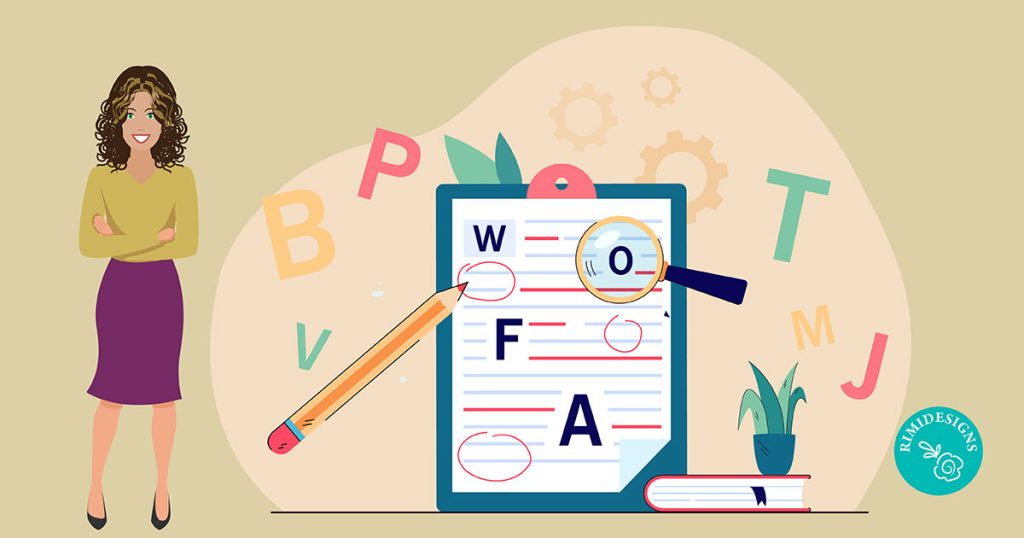
5 Common Mistakes in Proofreading and Editing
Congratulations! You’ve written your final draft and you’re ready to post it straight to your blog. But wait! Have you proofread and edited what you’ve written?
Take time to study the following common mistakes in proofreading and editing, and learn strategies for avoiding them. Your final draft will be in top form.
1. Relying on spell check
While an automatic spell check often works well at catching common spelling mistakes, you can’t trust it completely. Spell check won’t spot words that are spelled correctly, but used incorrectly. Think of homonyms – words that sound alike, but have different meanings and spellings, such as “sea” and “see”. Once you’ve used spell check, proofread and edit your work again.
Spell check also won’t help with other common errors, such as misusing possessives and contractions. Take “its” versus “it’s”. “Its” is the possessive form of “it”. “It’s”” is the contraction of “it is” or “it has”. If you’re ever stuck on which one to use, read the sentence aloud using “it is” or “it has”. The same holds true for “your” versus “you’re”. Would you say, “Pass me you are book”? No. You would use “your”.
2. Incorrect punctuation
Some writers seem fond of throwing in a comma after every couple of words, while others seem never to have heard of this popular, and often misused, punctuation mark. Remember that commas and other punctuation marks are used to clarify the meaning of a sentence.
Use commas to signal a pause, to separate items in a series or when joining two independent sentences with a conjunction (for, and, nor, but, or, yet, so).
Commas are also used when signaling a non-restrictive element – that is, a word, phrase, or clause that can be deleted without altering the basic meaning of the sentence. For example: Maria, who was the class representative, spoke first.
Do not use commas with a restrictive element. A restrictive element is a word, phrase or clause that cannot be deleted without changing the sentence’s meaning. For example: The man who committed the crime was never caught.
Proofread and edit your text for comma splices, as well. A comma splice is when two or more independent clauses are written with only a comma between them. Separate the clauses with a period or semicolon, or connect the clauses with words like and, for, because or although.
3. Subject-verb agreement
Tools such as Autocorrect often fail when it comes to subject-verb agreement. Problems with subject-verb agreement usually arise when other words come between the subject and the verb. In such cases, it’s easy to mistake the noun nearest the verb as the verb’s subject.
For example, it’s tempting to read the following sentence as correct: A group of three or more people are needed for the trip. But the subject of the sentence is “group”, not “people”, and “group” is singular. Thus, the sentence should read: A group of three or more people is needed for the trip.
When proofreading and editing texts, circle the subject and verb in each sentence and be sure they agree.
4. Me versus I and myself
“I” is the subject and “me” is the direct object. Do you say “between you and I” or “between you and me”? You wouldn’t say “between we”, instead you would say “between us”. If you’re stuck on which is correct, keep in mind that “us” is “you and me” and “we” is “you and I”.
Also, you cannot take a preposition – such as “between” – and mix and match subjects and objects. There is no such thing as “between she and him”. Write “between her and him”, or better yet, “between them”.
“Myself” is a reflexive pronoun and should only be used if you’ve already used “I” in the sentence. For example: I myself had already decided to go on the trip.
5. Read your work aloud
The absolute best way to proofread and edit is to read aloud. Your ear will catch mistakes your eye cannot. It’s also a good idea to read your work “cold”. Allow yourself time between completing the final draft and proofreading and editing. You’ll catch more errors this way.
SOURCE: Fiverr



